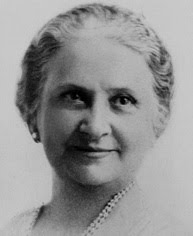
Dr. Maria Montessori
Dr. Maria Montessori (1870-1952) first made history by being the first woman physician in Italy- she later became the world famous educator and Psychologist with her research and experimentation in early childhood development.
Her first interest as a physician was to take care for deficient and retarded children where, basing her work on the principles involved by two French doctors and educators- Sequin and Itard.
She found she was able to bring a few of these children to a higher level of development that enabled them to enter public schools and successfully compete with normal children.
This led her to look more closely into the natural ways of development of normal children. Her observations made her realize that the natural aptitude of children and their potential for development were being overlooked and not harnessed in a way that would bring the greatest benefit to their growth. She delved deeply into how children learn how they build themselves from what they find in their immediate environment. She had the intuition and insight to recognize that a growing child has keen sensitivities and higher absorbent mind. That children take in impressions and learn patterns of behavior, knowledge and skills through a series of personal experiences offered in the environment around them, and that these are the first steps of learning in their lives.
In 1906, she accepted the challenge to work with children in the San Lorenzo district of Rome. It was here that she found the first “Casa dei Bambini”. Here is where the Montessori Method of education was developed. Every Exercise, every method, every piece of equipment Dr. Montessori developed was based on what she observed children to do naturally, by themselves, unassisted by adults. She summarized these experiments in her first book titled, “The Discovery of the Child”.
Dr. Maria Montessori began her career as an educator of children working with a group of 50 children, 3 – 5 years old, on January 6, 1907 in the city of Rome. She had at her disposal an untrained assistant, a room, a bit of furniture and developmental materials to aid sense perception that she had previously used when working with mentally handicapped children. Those children who were older had to be encouraged before their interest was aroused. Once enticed to use the material their attention was volatile. Dr. Montessori was astonished to see that the little ones, however, were intensively attracted by the materials, working spontaneously and repeated with them in total concentration.
Being a scientist, Dr. Montessori observed and responded to this phenomenon of spontaneous work generated by the apparatus. Little by little, she created a highly specialized form of materials, which to the children afforded a source of profound satisfaction. In addition, she provided an environment suited to and respectful of children’s inherent characteristics, “the prepared environment”
Out of this experimental foundation, the Montessori Methods of Education evolved. Observing the quality of interaction between the children and their environment, and the choice and rejection of materials placed at the children’s disposal, Dr. Montessori formulated a comprehensive science of human life in all its aspects and manifestations.
The present range of Montessori materials has in effect been selected by the children of the world in response to their inner directives. A common misconception holds these materials to be teaching aids, tools that will help teachers convey those matters, which adults believe children must learn. Their function is, however, of far greatest scope. Adults can teach children a limited amount of facts. The knowledge children can acquire if they are free to follow their inner dictates is unlimited. The Montessori Educational Apparatus is self directed in that it provides the children with motives of purposeful activity perfectly adopted to each stage of their development.
In order for the children to derive optimum benefit from the use of the materials, certain conditions are absolutely necessary. The first and the foremost of their conditions is that the adults in charge of a Montessori environment must be well versed in Montessori pedagogy and have a thorough knowledge of the materials, their use, their possibilities and their scope. Equally important is that the materials shall be complete, clean and in perfect condition. A premises that makes this possible is that they be constructed of high quality prime materials for maximum durability and built to precise specifications. These requirements appear rigid and arbitrary until it is understood that it is precisely their inherent order and exactness which so intensively attracts the children.
Dr. Maria Montessori died in Noordwijk, Holland, in 1952. Her invaluable work and discoveries are still in practice today. There are numerous Montessori schools around the world, each carrying on her profound methodology to help in the education of young children.
